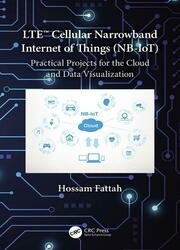 Название: LTE Cellular Narrowband Internet of Things (NB-IoT) : Practical Projects for the Cloud and Data Visualization
Название: LTE Cellular Narrowband Internet of Things (NB-IoT) : Practical Projects for the Cloud and Data VisualizationАвтор: Hossam Fattah
Издательство: CRC Press
Год: 2021
Страниц: 380
Язык: английский
Формат: pdf (true)
Размер: 52.3 MB
Cellular communications and networks have evolved dramatically during the past few decades: WiFi, WiMax, ZigBee, Bluetooth, RFID, 2G/3G systems (GSM®, EDGE, GPRS), and finally 4G/5G systems (LTE, LTE Advanced, LTE Advanced Pro, and New Radio). These cellular networks have become the de-facto standard in daily life and routine. They have been used by billions of users around the globe and their use grows every day. This is because most of the cellular technology transformed from a voice-centric technology to a technology that supports modern applications and features such as rich multimedia, Machine Learning (ML), Artificial Intelligence (AI), native cloud and virtualization support, Big Data, and smart applications.
5G cellular technology is the most recent broadband cellular technology aiming at increasing data rates and providing connected devices that can be used in different smart applications such as home appliances, smart transportation, smart building, and smart cities.
NB-IoT is the Internet of Things (IoT) technology used for cellular communication. NB-IoT devices deliver much better capability and performance, such as: increased area coverage of up to one kilometer; a massive number of devices―up to 200,000―per a single base-station area; longer battery lifetime of ten years; and better indoor and outdoor coverage for areas with weak signal, such as underground garages.
The cellular NB-IoT technology is a challenging technology to use and understand. With more than 30 projects presented in this book, covering many use cases and scenarios, this book provides hands-on and practical experience of how to use the cellular NB-IoT for smart applications using Arduino, Amazon Cloud, Google Maps, and charts.
The book starts by explaining AT commands used to configure the NB-IoT modem; data serialization and deserialization; how to set up the cloud for connecting NB-IoT devices; setting up rules, policy, security certificates, and a NoSQL database on the cloud; how to store and read data in the cloud; how to use Google Maps to visualize NB-IoT device geo-location; and how to use charts to visualize sensor datasets.
Projects for Arduino are presented in four parts. The first part explains how to connect the device to the mobile operator and cellular network; perform communication using different network protocols, such as TCP, HTTP, SSL, or MQTT; how to use GPS for geo-location applications; and how to upgrade NB-IoT modem firmware over the air. The second part explains the microcontroller unit and how to build and run projects, such as a 7-segment display or a real-time clock. The third part explains how NB-IoT can be used with sensor devices, such as ultrasonic and environmental sensors. Finally, the fourth part explains how NB-IoT can be used to control actuators, such as stepper motors and relays.
This book is a unique resource for understanding practical uses of the NB-IoT technology and serves as a handbook for technical and non-technical readers who are looking for practicing and exercising the cellular NB-IoT technology. The book can be used by engineers, students, researchers, system integrators, mobile operators’ technical staff, and electronics enthusiasts.
Скачать LTE Cellular Narrowband Internet of Things (NB-IoT) : Practical Projects for the Cloud and Data Visualization